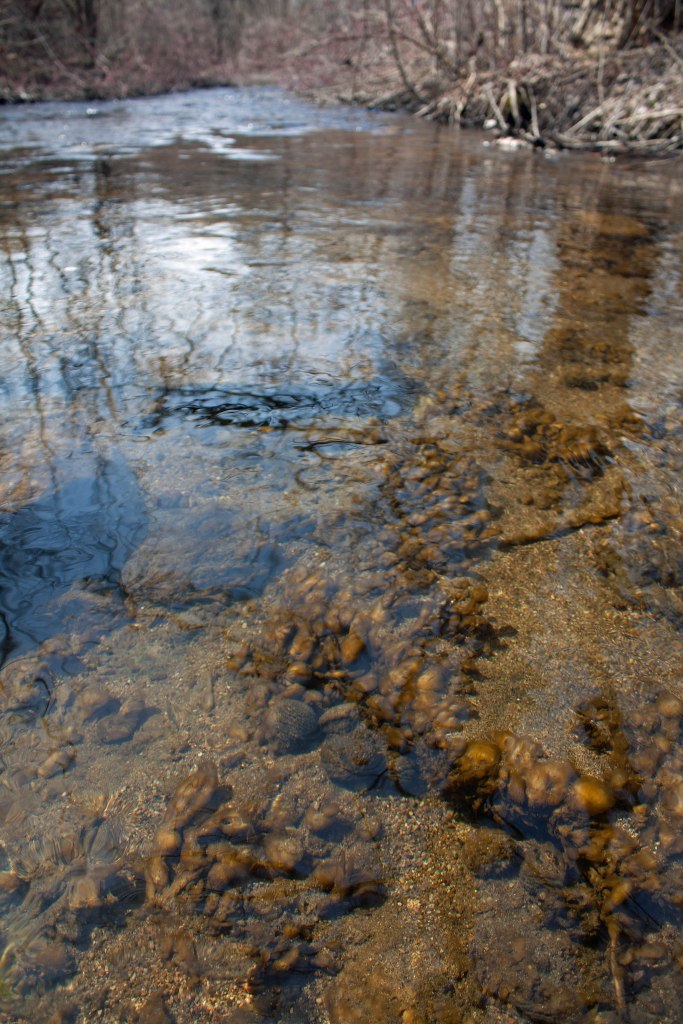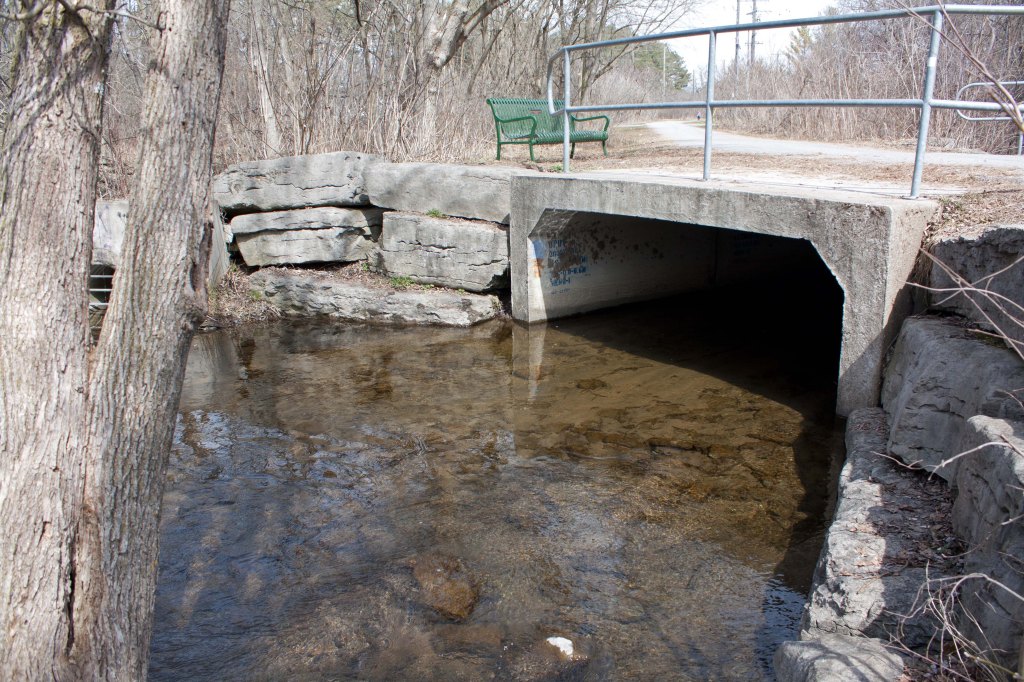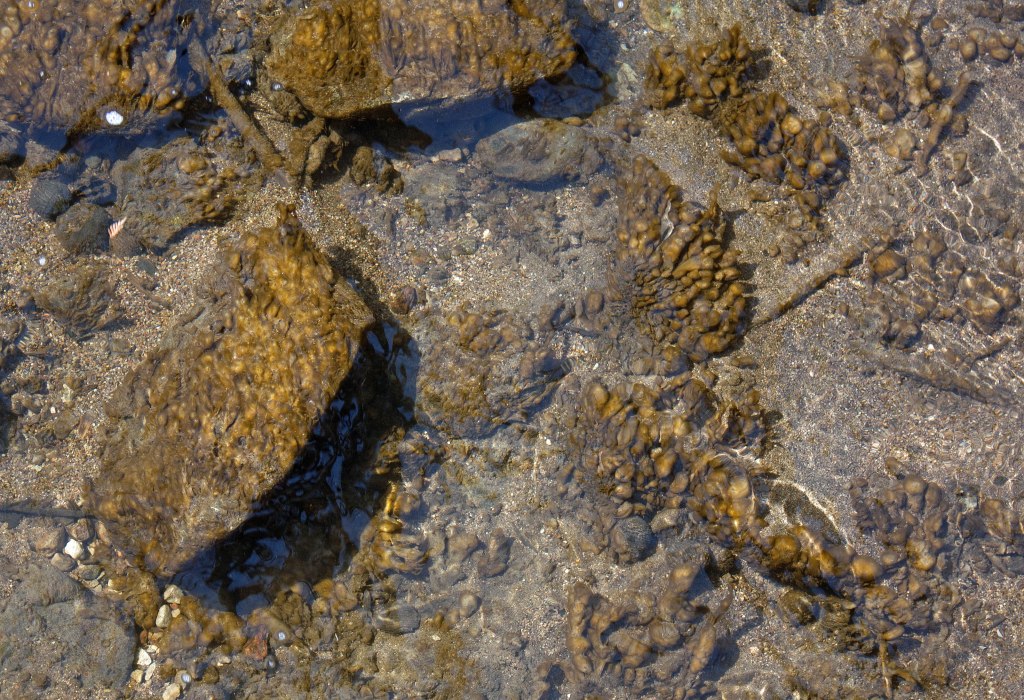
It was a warmish day in early spring, when the alders and red maples were budding and flowering but everywhere else winter’s clinging greys and browns still gripped the earth in stasis.
My usual walk along the creek took me to a bridge where I discovered extensive green-brown growths on the rocks and sand. They formed clumps of golden ‘bulbs’ of colonial periphyton (attached algae) that swayed in the current like grass in the wind. They were effusive, I thought. What could be growing here with such enthusiasm so early in spring?
Of course, I had to answer that question!
I returned with a sample jar and collected a few ‘bulbs’ that were very slimy; I lost a few as they slithered out of my hand; they plopped in the water and were carried downstream by the current. This is exactly how periphyton colonize a stream, taking advantage of a disturbance by simply drifting downstream to a new location where they reattach and grow.
I noticed that the golden algae ‘bulbs’ colonized both the sand-gravel stream bottom as well as the rocks and cobbles. In both cases they formed ‘bulbs’ that swayed in the current, enabling them to capture more light in the partially shaded stream
Algae attach to just about any surface underwater and have shown preferences for types of surface. Phycologists have studied the different freshwater algal communities that form on a particular substrate and named them. For instance epipsammic periphyton attach to sand; epipelic periphyton attach to sediment; epilithic periphyton attach to rock; and epiphytic periphyton attach to the underwater surfaces of aquatic plants and wood.
When I put a blob under the microscope, I had to laugh; of course, they were all diatoms! I recognized several genera, the usual suspects that form gelatinous tubes or stalks in small freshwater streams: Cymbella, Gomphonema, Fragilaria, Synedra and Achnanthes. The slippery nature of the colony comes from the gelatinous material the diatoms grow in (tubes) or sit on (stalks) that allow them to attach to a surface. Diatoms can be found in streams all year round and tend to fair better than other algae in cold water. Being rapid growers these diatoms had responded to the recent warm weather and the nutrient pulse from spring thaw. The light, both duration and intensity, had been steadily increasing in the last few weeks. This was enough to spark a bloom. The location, just off the Rotary Trail, was downstream of a large sub-division of fairly new houses and runoff from the streets enters Thompson Creek. Nutrients released in the spring could arise from a number of sources: fertilized lawns and gardens, detergent runoff from car washing, street debris, just to name a few (see my articles on urban runoff).
Diatoms are unicellular, photosynthetic, usually free-moving algae (Division Chrysophyta, Class Bacillariophyceae) that have a specialized frustule made of silica with a two-layered outer shell (thecae). They are usually golden-brown in colour because of the pigments in their chloroplasts. Along with chlorophylls, diatoms contain fucoxanthin and beta carotene, which gives them a golden brown colour.

Forming the Diatom Forest
Think of how a terrestrial forest forms through succession after a fire or other clearing (first with mosses, forbs, graminoids and shrubs, then young saplings of pioneer trees establishing understory and eventually overstory with a mature tree canopy); that’s very much how a diatom forest forms. The key is attachment: diatoms adhere to submerged surfaces through mucilage produced between the frustule (the diatom’s outer shell) and its substrate. The form of the mucilage varies and includes gelatinous stalks, pads and tubes.
Attachment and colonization starts with a ‘clean’ unpopulated surface (usually scoured by turbulence in a storm or some other event or a new surface tumbled into the water). Several stages of succession take place, starting with early colonizers. The adnate Cocconeis placentula, whose frustules attach directly to the substrate, is an example of an early colonizer. When they attach to a substrate they form a biofilm (think moss in a terrestrial forest). Adnate species are eventually overgrown by taxa that produce a mucilaginous pad (e.g. Synedra) or stalk (e.g. Gomphonema). The understory layer is typically occupied by diatoms such as Fragilaria vaucheriae and Synedra radians that attach to the surface at one end (apical) of their rod-shaped frustules using a mucilaginous pad to form “rosettes” that resemble spiky understory shrubs. This allows them to protrude above the adnate taxa and take advantage of more light.

The diatoms Cymbella and Gomphonema produce long stalks that attach directly to the surface, allowing them to form a swaying canopy over the lower tier of cells of Fragilaria vaucheriae, Synedra radians and early colonizer Cocconeis placentula whose frustules attach directly to the substrate (think overstory and understory of a terrestrial forest or a marine kelp forest).

Just like trees, the canopy-forming stalked diatoms effectively compete for available light and nutrients in the water with their vertical reach. They provide the ‘overstory’ of the diatom forest’s vertical stratification. These tree-like diatoms also provide an additional surface for other diatoms to colonize (e.g. tiny epiphytic Achnanthes settle on the long stalks of Cymbella, just as lichen does on a tree trunk).
The stalked diatom forest acts like a net, trapping drifting-in euplankton, such as Pediastrum sp. and Fragilaria spp., which then decide to stay and settle in with the periphyton community. The mucilage captures and binds detrital particles in both lower and upper stories of the diatom forest; these, in turn, provide nutrients for the diatom forest and additional surfaces for colonization. In their work with periphyton communities, Roemer et al. (1984) found several diatoms (e.g. Diatoma vulgare, Fragilaria spp. Stephanodiscus minutula) entangled in the complex network of cells, stalks, and detritus of the diatom forest’s upper story. They also found rosettes of Synedra radians—like jungle orchids—attached to large clumps of sediment caught by the net of mucilage.
Eventually, ‘overgrowth’ occurs as the periphyton colony matures and grows ‘top-heavy’ with all this networking. The upper story of the community simply sloughs off—usually triggered by turbulence in a river from rains, storms, or dam release. This is similar to a forest fire in the Boreal forest, which creates space and light for new colonization and growth. The dislodged periphyton ride the turbulent flow, temporarily becoming plankton, and those that survive the crashing waters provide “seed” to colonize substrates downstream. Others may get damaged and form the ‘dish soap’ like suds or foam you often see in turbulent water. The proteins, lignins and lipids of the diatoms (and other associated algae) act as surfactants or foaming agents that trap air and form bubbles that stick to each other through surface tension.

References:
Lauterwasser, Alexander. 2006. “Water Sound Images: The Creative Music of the Universe.” Macromedia Publishing. 172 pp.
Munteanu, N. & E. J. Maly, 1981. The effect of current on the distribution of diatoms settling on submerged glass slides. Hydrobiologia 78: 273–282.
Munteanu, Nina. 2016. “Water Is…The Meaning of Water.” Pixl Press, Delta, BC. 584 pp.
Roemer, Stephen C., Kyle D. Hoagland, and James R. Rosowski. 1984. “Development of a freshwater periphyton community as influenced by diatom mucilages.” Can. J. Bot. 62: 1799-1813.
Schwenk, Theodor. 1996. “Sensitive Chaos.” Rudolf Steiner Press, London. 232 pp.
Wilkens, Andreas, Michael Jacobi, Wolfram Schwenk. 2005. “Understanding Water”. Floris Books, Edinburgh. 107 pp.


Nina Munteanu is a Canadian ecologist / limnologist and novelist. She is co-editor of Europa SF and currently teaches writing courses at George Brown College and the University of Toronto. Visit www.ninamunteanu.ca for the latest on her books. Nina’s bilingual “La natura dell’acqua / The Way of Water” was published by Mincione Edizioni in Rome. Her non-fiction book “Water Is…” by Pixl Press (Vancouver) was selected by Margaret Atwood in the New York Times ‘Year in Reading’ and was chosen as the 2017 Summer Read by Water Canada. Her novel “A Diary in the Age of Water” was released by Inanna Publications (Toronto) in June 2020.




One thought on “A Diatom Spring…”